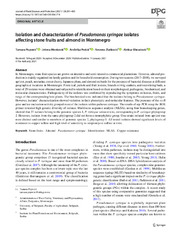Приказ основних података о документу
Isolation and characterization of Pseudomonas syringae isolates affecting stone fruits and almond in Montenegro
| dc.creator | Popović Milovanović, Tatjana | |
| dc.creator | Menković, Jelena | |
| dc.creator | Prokić, Anđelka | |
| dc.creator | Zlatković, Nevena | |
| dc.creator | Obradović, Aleksa | |
| dc.date.accessioned | 2023-12-07T17:33:39Z | |
| dc.date.available | 2023-12-07T17:33:39Z | |
| dc.date.issued | 2021 | |
| dc.identifier.issn | 1861-3829 | |
| dc.identifier.uri | https://enauka.gov.rs/handle/123456789/776640 | |
| dc.identifier.uri | https://plantarum.izbis.bg.ac.rs/handle/123456789/1185 | |
| dc.description.abstract | In Montenegro, stone fruit species are grown on intensive and semi-intensive commercial plantations. However, almond production is mainly organized on family gardens and for household consumption. During two seasons (2017–2018), we surveyed apricot, peach, nectarine, sweet cherry, Japanese plum, and almond orchards for the presence of bacterial diseases at different geographical locations in Montenegro. From leaf, petiole and fruit lesions, branch or twig cankers, and necrotizing buds, a total of 29 isolates were obtained and subjected to identification based on their morphological, pathogenic, biochemical, and molecular characteristics. Pathogenicity of the isolates was confirmed by reproducing the symptoms on leaves, fruits, and twigs of the corresponding host plants. The biochemical tests indicated that the isolates belong to Pseudomonas syringae. However, isolates’ characterization showed variation in their phenotypic and molecular features. The presence of the syrB gene and ice nucleation activity grouped most of the isolates within pathovar syringae. The results of rep-PCR using the BOX primer revealed high genetic diversity of isolates. Multilocus sequence analysis (MLSA), using four housekeeping genes, showed that 27 isolates belong to the genomic species 1, P. syringae sensu stricto, corresponding to P. syringae phylogroup 2. However, isolates from the same phylogroup 2 did not form a monophyletic group. One strain isolated from apricot was most distinct and similar to members of genomic species 2, phylogroup 3. All tested isolates showed significant levels of resistance to copper sulfate and high level of sensitivity to streptomycin sulfate in vitro. | sr |
| dc.language.iso | en | sr |
| dc.publisher | Springer | sr |
| dc.relation | info:eu-repo/grantAgreement/MESTD/inst-2020/200116/RS// | sr |
| dc.relation | info:eu-repo/grantAgreement/MESTD/inst-2020/200010/RS// | sr |
| dc.rights | openAccess | sr |
| dc.rights.uri | https://creativecommons.org/licenses/by/4.0/ | |
| dc.source | Journal of Plant Diseases and Protection | sr |
| dc.title | Isolation and characterization of Pseudomonas syringae isolates affecting stone fruits and almond in Montenegro | sr |
| dc.type | article | sr |
| dc.rights.license | BY | sr |
| dc.citation.epage | 405 | |
| dc.citation.issue | 2 | |
| dc.citation.spage | 391 | |
| dc.citation.volume | 128 | |
| dc.type.version | publishedVersion | sr |
| dc.identifier.doi | 10.1007/s41348-020-00417-8 | |
| dc.identifier.fulltext | http://plantarum.izbis.bg.ac.rs/bitstream/id/3694/s41348-020-00417-8.pdf | |
| dc.identifier.scopus | 2-s2.0-85099092864 | |
| dc.identifier.wos | 000607007100001 |


